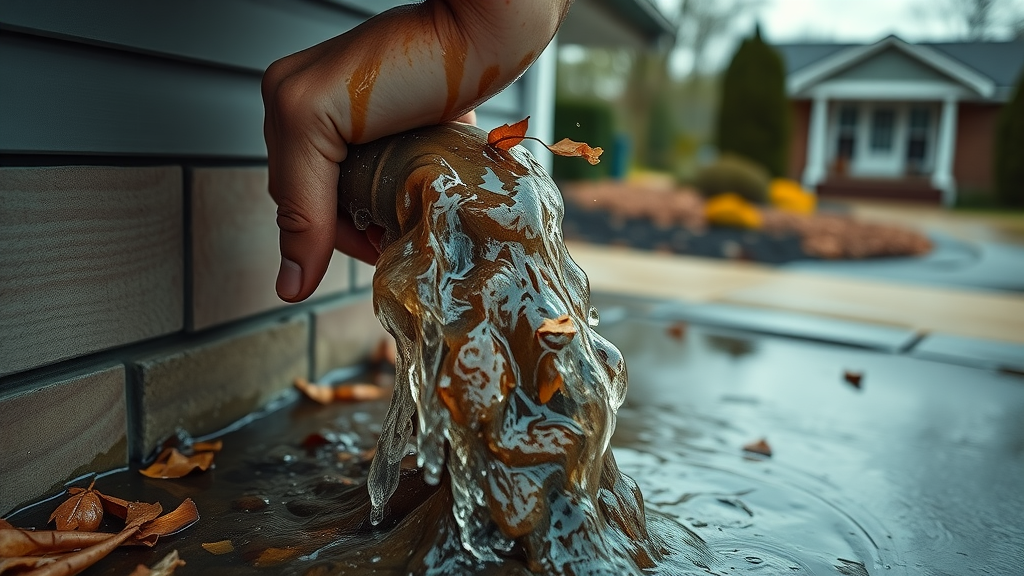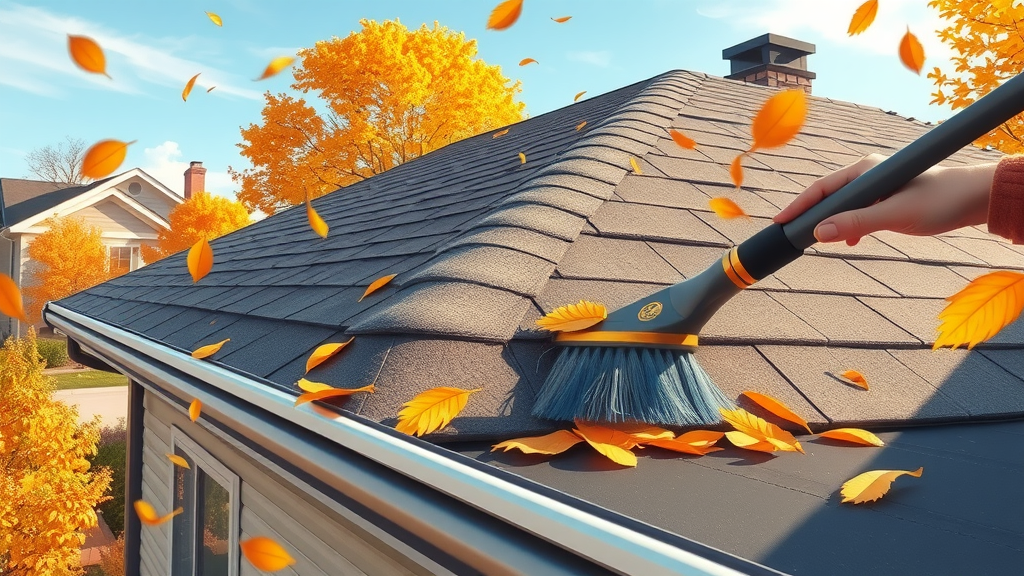Ever wondered if your biggest home water damage risks are hiding right above you? Many homeowners overlook the silent threats lurking in their gutters and downspouts until costly repairs are needed. Could a clogged downspout be the real culprit behind foundation issues or unexpected leaks? In this comprehensive guide, you'll discover practical, simple but powerful solutions to maintain a high-performing gutter system for peace of mind.
Are You Overlooking the Hidden Cause of Home Water Damage? How to Clean Clogged Gutter Downspouts Fast
Your gutter downspout is your home's first line of defense against water damage. When gutters and downspouts become clogged, water flow is obstructed, often resulting in structural problems like foundation cracks and landscape erosion. Learning how to clean clogged gutter downspouts ensures water flows away from your house as intended. Overlooking this seemingly small maintenance task can lead to expensive issues that add up over time.
By prioritizing regular gutter cleaning and understanding how a clogged downspout forms, you gain the knowledge to protect your home efficiently. This guide covers practical steps for unclogging, recommended tools, maintenance tips, and expert strategies. You'll even learn when a plumbing snake or power washer is best, plus get a maintenance checklist for lasting results. Let’s dive in to transform your gutter system’s health.
- In this guide, you'll discover the exact steps to how to clean clogged gutter downspouts, why regular gutter downspout maintenance matters, essential tools for gutter cleaning, and expert tips to unclog a downspout efficiently.

Understanding Gutter Downspout Functionality and Common Blockages
How gutter downspouts work with gutters and downspouts
Gutters and downspouts act as a unified drainage system, channeling rainwater from your roof away from your home's foundation. Gutters collect the runoff, guiding it toward the gutter downspout , which directs water downward and away from your property. When everything flows freely, there's little risk of water pooling or seeping into the ground near your foundation. However, even the most robust setup will fail if routine cleaning is ignored. Small blockages—whether from leaves and other debris or accumulated dirt—can disrupt water flow and cause the system to overflow.
Understanding this process is crucial. Your gutter system isn't just about keeping your roof dry—it also protects siding, window frames, landscaping, and basements from intrusive moisture. If there’s ever a breach, water flows exactly where you don’t want it: right into the vulnerable parts of your home. That’s why it’s important to learn not only how downspouts function, but also the best practices to unclog a downspout before a minor issue becomes a major headache.
Most frequent causes of a clogged downspout
There are several reasons a clogged downspout might develop. The most common culprit is an accumulation of leaves or debris during fall and spring, especially if you live in an area with mature trees. Wind pushes these materials into gutters, where they eventually make their way into the downspout. Over time, sediment, roof grit, and even bird nests can build up, creating a stubborn clog in your downspout that stops even moderate water flow.
Other frequent contributors include ice dams forming in winter, attic shingle granules, and the occasional small toy or ball. Once the debris is packed tight—often at bends or places where the downspout is buried into the ground—rainwater is forced to back up and spill over. Recognizing these causes lets you choose the right strategy, such as a plumbing snake or power washer, for efficient gutter cleaning.
Why clean your gutter matters for home protection
If you neglect to clean your gutter regularly, you're risking costly consequences. Continuous overflow can cause water damage to your siding, foundation, and landscaping, or even lead to soil erosion. Gutter systems clogged over several seasons can also encourage mold growth, attract pests, and damage soffits and fascia boards. Ultimately, regular cleaning—especially before or after storms—provides peace of mind, ensures your home stays protected, and can prevent thousands in repairs down the road.
| Blockage Type | Where It Occurs | Prevention Tip |
|---|---|---|
| Leaves and Twigs | Gutter Channel/Downspout Entry | Install mesh gutter guards, regular seasonal cleaning |
| Shingle Grit | Downspout Bends | Flush gutters annually, check after roof replacement |
| Ice Dams | Downspout Elbows | Improve attic insulation and ventilation |
| Nests or Toys | Outlets and Downspout Terminations | Inspect regularly, use fine mesh covers |
Signs Your Gutter Downspout is Clogged
Visual cues and water overflow issues
The telltale signs of a clogged downspout appear quickly after a moderate rainfall. Water may spill over the sides of your gutters rather than flowing out the bottom of the downspout—often causing noticeable puddles around your foundation or stained siding. Dirty streaks, water lines, and even visible plant growth inside gutters are all red flags. If you notice splashing, persistent drips, or residue where water should be draining clear, it's time to suspect a blockage.
Sometimes, you’ll spot water trickling slower than usual, which can indicate a partial clog. Visual checks, especially after storms, are essential. Detecting these early symptoms means you can unclog a downspout before water damage to your home occurs and before more difficult blockages take hold.
Other warning signs of clogged downspouts
Beyond obvious overflows, pay attention to subtle clues. Sagging gutters, peeling paint, mildew or algae growth on siding near gutter lines, and a musty smell inside basements or crawl spaces can signal water isn't being carried away properly. Unexplained foundation cracks or persistent damp patches around your house perimeter are also strong indicators of a blocked gutter downspout .
Listen for gurgling sounds in your downspouts during a rainstorm, which can suggest trapped water and debris. Early detection is key; when these warning signs arise, schedule a thorough gutter cleaning before more significant problems develop.

"Neglecting gutter cleaning can cost homeowners thousands in preventable repairs." – National Home Maintenance Association
- Water overflowing gutters or backed up at downspout exit
- Pools of water or erosion near the home’s foundation
- Sagging or separated gutter sections
- Mildew, staining, or peeling paint near downspouts
- Growth of moss or weeds in gutter lines
How to Clean Clogged Gutter Downspouts: Step-by-Step Instructions
Safety gear and preparation before you clean your gutter
Before you begin, make safety your top priority. Wear gloves to protect your hands from sharp debris, bacteria, or pests often hidden in gutters. Use sturdy, non-slip footwear and ensure all ladders are placed on firm ground—the safest way to clean your gutter is with a partner spotting you. Gather essential tools, such as a bucket for debris, a gutter scoop, a plumbing snake or a garden hose, and safety goggles for eye protection. Check your area for overhead hazards like power lines, and never stretch beyond your comfort zone while on a ladder.
Preparation is key: Assemble your equipment near the work area to avoid unnecessary trips up and down the ladder. Clear the ground below and keep pets and children away during cleaning. The right setup is a simple but powerful way to prevent injuries and make the job go smoothly. With safety in mind, you're ready for efficient gutter downspout cleaning.

Manual removal: unclog a downspout using hands or small tools
Manual cleaning is the most direct method for minor clogged downspout issues. Start by removing the downspout outlet cover and using gloved hands or a gutter scoop to clear visible debris. Insert the end of a flexible sewer brush or similar tool into the top of the downspout to loosen packed material. Work patiently, pulling out leaves, twigs, and sediment. If the clog persists, use a garden hose with moderate water pressure to flush the passage. The combination of hand removal and water flow can often restore complete drainage—make sure all debris is disposed of away from your home's foundation to prevent re-entry.
This low-tech approach is not only inexpensive but also gives you valuable insight into your gutter system’s overall health. It’s best for seasonal upkeep when blockages are caught early. For deeper or more stubborn clogs, step up your technique with specialized tools.
Using a plumbing snake to unclog a downspout
For more persistent blockages, a plumbing snake or drain auger can be a game-changer in your gutter cleaning arsenal. Position your ladder securely near the downspout opening. Insert the snake into the top entrance, gently pushing and twisting while advancing deeper into the pipe. As you encounter resistance, continue rotating the tool—this helps break up packed debris or roots that standard hand cleaning can’t reach. After working through the obstruction, slowly retrieve the snake to pull out loosened material.
Once clear, run a strong stream of water down the pipe with a garden hose to double-check your results. If water flows freely out the bottom of the downspout, you’ve successfully addressed the clog. This method works especially well on older gutter downspouts or those buried into the ground where clogs tend to accumulate.

Applying a power washer for stubborn blockages
Some clogs simply won’t budge with manual or snake methods. In such cases, harness the force of a power washer for high-pressure removal. Fit your power washer with a suitable nozzle and insert it partially into the top of the downspout—never force the tip if resistance is high. Gradually increase water pressure and move the nozzle in a gentle, controlled motion. This high-pressure method blasts out compacted leaves, mud, and grit. Place a tarp or splash guard at the downspout’s bottom to contain debris and water spray.
Apply several short bursts of power and flush again with a garden hose. If the blockage is severe, repeat from both the top and bottom, ensuring all sections are clear. Always avoid excessive force in fragile or old metal downspouts—opt for lower pressure or a plumbing snake if you’re unsure. Once clear, you’ll notice immediate improvement in your gutter system’s functionality.
| Method | Best For | Advantages | Precautions |
|---|---|---|---|
| Manual Removal | Light to moderate blockages | Low cost, close inspection, gentle on materials | May not reach deep or buried clogs |
| Plumbing Snake | Stubborn or packed debris in bends | Effective for deep clogs, reusable tool | Risk of pipe scratching, requires some skill |
| Power Washer | Heavy/mud-packed clogs, old sediment | High pressure, fast results, clears tough obstructions | Can damage old gutters; use correct pressure/nozzle |
Preventive Maintenance for Gutter Downspouts
Routine gutter cleaning best practices
To avoid the hassle of repeated clogged downspouts , set a regular schedule for gutter cleaning —at least twice a year in spring and fall or more often if you have overhanging trees. Begin by clearing loose debris from gutters and downspout openings. Use a garden hose to flush small particles toward the outlets, always moving away from the house. For large properties, enlist the help of a leaf blower or specialized gutter cleaning wand to speed things up. Inspect all attachment points, looking for sagging or separated sections.
Adding biannual checks after major storms ensures early detection of potential issues. Keeping a seasonal log helps document clogs and patterns. Combining regular cleanings with gutter guard installation provides year-round protection and less frequent maintenance needs.

Gutter downspout guards and filters
Installing gutter guard systems or downspout screens acts as the first layer of defense against debris. Mesh covers, foam inserts, and cup-style filters all help trap leaves and twigs before they can enter the downspout channel. Choose products designed for your specific gutter size and shape for best results. While no guard is 100% maintenance-free, they dramatically reduce large debris buildup and minimize your need to frequently unclog a downspout.
Regularly check your guards for tears or displacement after storms, as even the best filters need occasional adjustment or replacement. When paired with scheduled cleanings, these tools ensure long-term, clog-free performance and better water flow through your entire gutter system.
- Inspect and clean gutters at least twice yearly—spring and fall
- Install gutter guards and downspout screens for extra protection
- Flush downspouts with a garden hose after each cleaning
- Immediately clear visible debris after heavy storms
- Check for leaks, loose connections, or sagging gutter sections
Recommended Tools and Products to Unclog a Downspout
Essential gutter cleaning tools: gloves, ladders, downspout cleaning tools
Having the right equipment is essential for effective gutter downspout maintenance. At minimum, your toolkit should include heavy-duty gloves , a sturdy ladder, a gutter scoop or trowel, and a bucket for debris. For more stubborn clogs, opt for a plumbing snake or drain auger. A high-quality garden hose with various spray nozzles helps with flushing blockages, while a power washer offers the muscle needed for severe issues or packed mud.
For larger homes, telescoping gutter cleaning wands and extension poles help you reach high or awkward spots safely. Invest in a headlamp or hands-free flashlight for shaded areas, and always keep spare fasteners and sealant handy for spot repairs. Well-chosen tools save time, improve safety, and maximize results every time you clean your gutters.
When to use a power washer versus a plumbing snake
When facing minor or moderately stubborn debris, a plumbing snake is your go-to—especially for bends or clogs deep within the downspout channel. It's gentle on most materials and highly effective for packed leaves. However, if the blockage is made up of fine sediment, silt, or layers of wet debris, a power washer is far more efficient. The high-pressure stream quickly dislodges and flushes out clogs, especially when used from both the top and bottom of the downspout.
Remember—always choose the method that matches the severity of the problem and the downspout’s material. Use low or medium pressure for older metal pipes, and reserve maximum power for PVC or reinforced systems where durability isn't a concern.
- Gutter cleaning scoop for manual removal
- Plumbing snake for deep or stubborn blockages
- Downspout cleaning wand for hard-to-reach places
- Garden hose with high-pressure nozzle for flushing debris
- Power washer for thick sediment and heavy clogs
- Mesh guards, screens, and filters for prevention
How to Clear a Clogged Gutter Downspout?
Stepwise highly-effective unclog a downspout technique
Answer: Start by inspecting the gutter downspout for visible debris. Use gloved hands to remove blockages at the top. If the clog remains, insert a plumbing snake into the downspout and twist it to dislodge packed material. Flush with a garden hose or power washer to ensure free water flow. Repeat as needed until the gutter downspout drains fully.
How to Clear a Blocked Gutter Downpipe?
Best techniques for blocked gutter downspout clearance
Answer: Use a ladder to access the downpipe opening. Remove leaf buildup by hand or with a gutter scoop. For tough blockages, use a power washer nozzle placed inside the downpipe, working from both the top and bottom if possible to dislodge debris. Finalize by running a steady stream of water to verify all clogs are dissolved.

What Tool is Used to Clean Gutter Downspouts?
Tools for traditional versus advanced gutter cleaning
Answer: The most effective tools for how to clean clogged gutter downspouts include a plumbing snake, gutter cleaning scoop, downspout cleaning wand, and a power washer. Select based on severity and access flexibility.
How Do I Know If My Gutter Downspout is Clogged?
Simple tests to determine clogged downspouts
Answer: Pour water into the gutter and observe flow out the bottom of the downspout. If the water backs up, trickles slowly, or overflows the gutter, the downspout is likely clogged. Additional signs include gutter sagging and residue at downspout outlets.
Frequently Asked Questions About How to Clean Clogged Gutter Downspouts
How often should I clean my gutter downspout?
You should clean your gutter downspouts at least twice a year —typically in spring and fall. If you live under large trees or in an area with frequent storms, consider quarterly cleaning or after every heavy wind event for best results.
Can I use household tools to unclog a downspout?
Simple hand tools like a broom handle or flexible wire can sometimes dislodge minor clogs, but for more effective and safe cleaning, it’s best to use a gutter scoop, plumbing snake, or power washer designed for the job.
How can I make gutter downspouts maintenance easier?
Install mesh gutter guards or downspout screens to prevent large debris from entering your system. Combine these with consistent, seasonal inspections and a quick flush using a garden hose to stay ahead of potential clogs.
Is a power washer safe for all gutter types?
Power washers are safe for most modern PVC or reinforced gutters but can damage older metal or painted systems if used at high pressures. Always start on the lowest setting and gradually increase as needed; test on a small, inconspicuous area first.
Expert Advice: Mistakes to Avoid When You Clean Your Gutter and Downspouts
Why skipping regular gutter cleaning is risky
Skipping regular gutter and downspout maintenance can cause damage to your home , including water infiltration, mold, pest problems, and structural issues. Even a minor clog can escalate into costly repairs if not addressed promptly, making preventive maintenance a must for every homeowner.
Typical errors during how to clean clogged gutter downspouts
Common mistakes include neglecting safety (not using gloves or a steady ladder), using high pressure indiscriminately, failing to check every downspout outlet, and not disposing of debris properly. Don’t forget to check your gutters after storms and always confirm water flows freely after each cleaning session.
Video: Watch How to Clean Clogged Gutter Downspouts
Step-by-step demonstration using a power washer
Demonstrational video showing a technician cleaning a gutter downspout with a power washer, from start to finish with safety tips and best practices.
Video: Professional Tips for Maintaining Gutter Downspouts
Quick Recap and Next Steps for Efficient Gutter Downspout Cleaning
- Clean your gutters and downspouts at least twice a year, more often in areas with heavy foliage.
- Use proper safety gear, check your gutters for visible blockages, and start with manual removal before advancing to a plumbing snake or power washer.
- Always confirm water flows out the bottom of the downspout after cleaning.
- Install guards or filters to reduce clog frequency.
- Stay proactive—with routine maintenance, you’ll save time, money, and stress.
 Add Row
Add Row  Add
Add 




Write A Comment